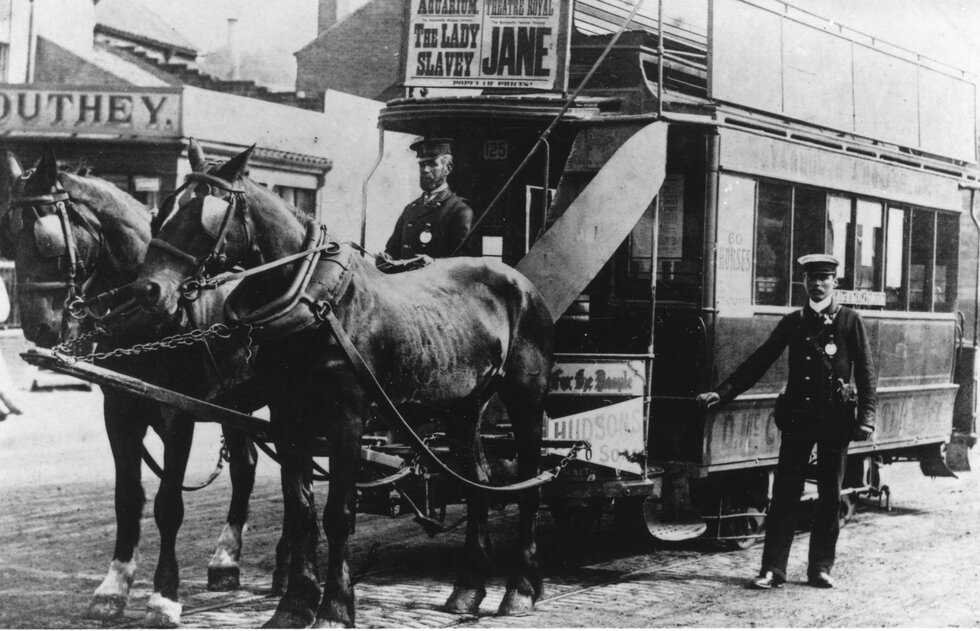On 25th March 1875, the opening of East Anglia’s first horse tramway, located in Gorleston-on-Sea, was celebrated. The town was situated on the west bank of the River Yare opposite the major fishing port and holiday resort of Yarmouth.
The two towns were linked by a lifting bridge, but it was not suitable for tramlines. Nevertheless, there were ambitious plans at the outset to link Gorleston with the neighbouring towns of Lowestoft, Southwold and Halesworth as part of an extensive 20-mile tramway. These failed to materialise and, after a series of short extensions, the Gorleston section of the tramway eventually ran from the Yarmouth South Town railway station to a terminus by the pier on the River Yare quayside. This journey of 2.75 miles took over two hours to complete.
The service was initially provided by a fleet of ten horse-drawn double deck trams. The fare for the full journey was either twopence (old money) or threepence. The higher fare entitled passengers to an inside seat, where the straw covered floor would help keep their feet warm.

Image 1: A busy and fairly early scene taken outside the tram depot at Feathers Plain, Gorleston (built in 1882). Photo undated, but from the style of the hats, almost certainly taken in the mid-1880s (National Tramway Museum collection).
Although it was initially built to a standard gauge, the single line with passing loops was re-laid and regauged to 3ft 6ins in 1882. This was possibly with a view to doubling the tracks, though this never happened. Indeed, the tramway struggled under a succession of owners and frequent changes of name, eventually becoming known as the Yarmouth and Gorleston Tramway Company.

Image 2: Horse car of the Yarmouth and Gorleston Tramways Company (photo: G.L. Gundrey Collection, National Tramway Museum).
By the turn of the century, the British Electric Traction Company had acquired a controlling interest in the company with a view to converting it to electric traction. BET was a massive conglomerate with extensive tramway interests throughout the country and overseas. By this stage, however, neighbouring Great Yarmouth Corporation had finally acquired powers to build its own tramway, also powered by electric traction. It vetoed BET’s proposals to electrify the Gorleston line and fiercely resisted the overtures it received from the BET to operate its new service.

Image 3: The last Gorleston horse tram? A notice in the saloon window advertises a forthcoming sale of 60 horses, including the two rather careworn looking animals awaiting passengers on Feathers Plain in the closing days of horse traction in July 1905. Photograph: Brian Ollington collection, published in David Mackley (2003), Great Yarmouth Tramways (Middleton Press).
Great Yarmouth’s tramway opened on 20th June 1902. Under the terms of the 1870 Tramways Act, the Corporation was entitled to compulsorily purchase the neighbouring Gorleston horse tramway once 21 years had elapsed since its opening. Having exercised its option, it took control of the horse tramway in March 1905 and began the process of converting the line to electric traction. So, just over thirty years after the tramway was opened, the last horse tram service was likely to have run on 4th July 1905, which was the date on which electric tramcars began operating the route.

Image 4: The end of an era, and the start of a new one. As one of the last horse cars pauses at Feathers Plain, one of the new replacement electric cars can be seen in the background by the new tramcar depot (National Tramway Museum collection).
Thereafter, the Yarmouth and Gorleston tramway was unusual in comprising two separate sections of tramway operating on opposite sides of the River Yare. By this time the total extent of the combined operation was just under ten miles.
With thanks to Museum volunteer Jim Dignan for producing this article.
Image References:
1. National Tramway Museum collection.
2. National Tramway Museum collection.
3. David Mackley (2003), Great Yarmouth Tramways (Middleton Press).
4. National Tramway Museum collection.
